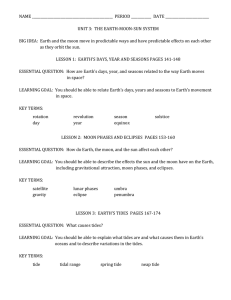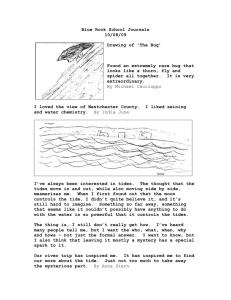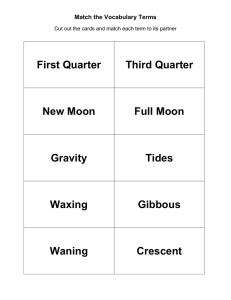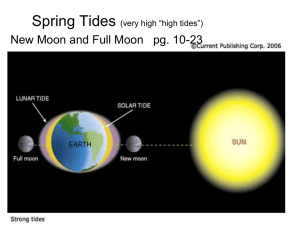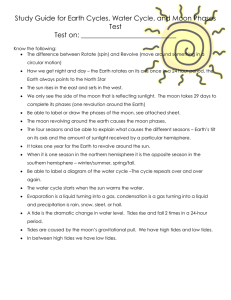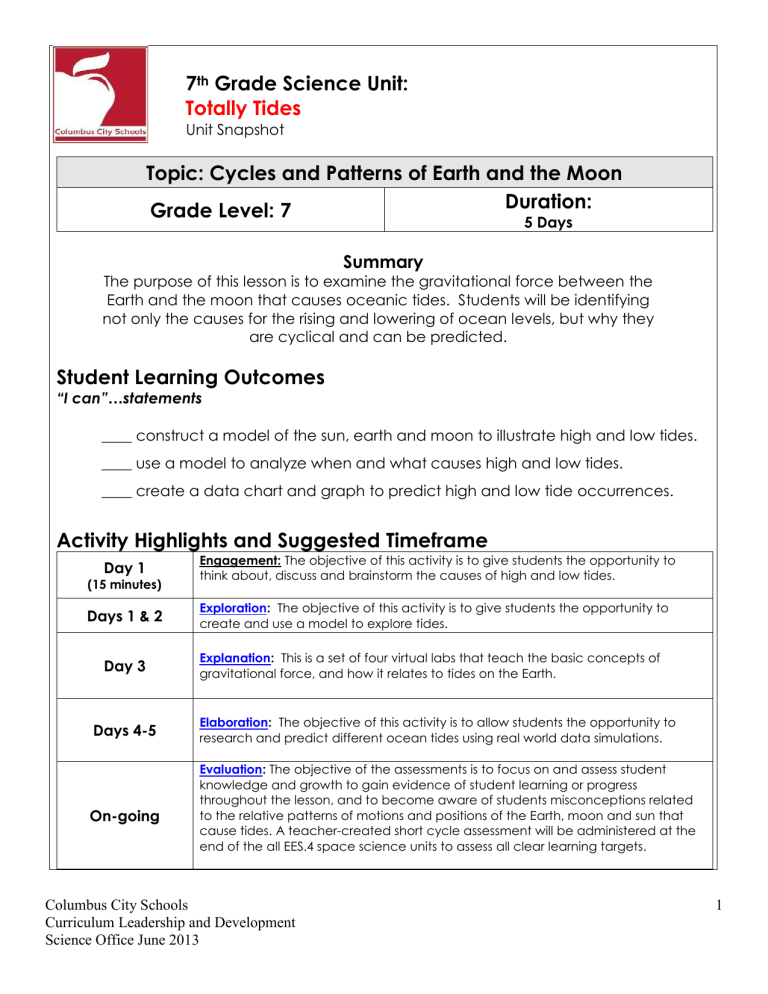
7th Grade Science Unit: Totally Tides Unit Snapshot Topic: Cycles and Patterns of Earth and the Moon Duration: Grade Level: 7 5 Days Summary The purpose of this lesson is to examine the gravitational force between the Earth and the moon that causes oceanic tides. Students will be identifying not only the causes for the rising and lowering of ocean levels, but why they are cyclical and can be predicted. Student Learning Outcomes “I can”…statements ____ construct a model of the sun, earth and moon to illustrate high and low tides. ____ use a model to analyze when and what causes high and low tides. ____ create a data chart and graph to predict high and low tide occurrences. Activity Highlights and Suggested Timeframe Day 1 (15 minutes) Days 1 & 2 Day 3 Days 4-5 On-going Engagement: The objective of this activity is to give students the opportunity to think about, discuss and brainstorm the causes of high and low tides. Exploration: The objective of this activity is to give students the opportunity to create and use a model to explore tides. Explanation: This is a set of four virtual labs that teach the basic concepts of gravitational force, and how it relates to tides on the Earth. Elaboration: The objective of this activity is to allow students the opportunity to research and predict different ocean tides using real world data simulations. Evaluation: The objective of the assessments is to focus on and assess student knowledge and growth to gain evidence of student learning or progress throughout the lesson, and to become aware of students misconceptions related to the relative patterns of motions and positions of the Earth, moon and sun that cause tides. A teacher-created short cycle assessment will be administered at the end of the all EES.4 space science units to assess all clear learning targets. Columbus City Schools Curriculum Leadership and Development Science Office June 2013 1 LESSON PLANS NEW LEARNING STANDARDS: 7.ESS.4 The relative patterns of motions and positions of the Earth, moon and sun cause solar and lunar eclipses, tides and phases of the moon. Gravitational forces between the Earth and the moon causes daily oceanic tides. When the gravitational forces from the sun and moon align (at new and full moons) spring tides occur. When the gravitational forces of the sun and moon are perpendicular (at first and last quarter moon), neap tides occur. SCIENTIFIC INQUIRY and APPLICATION PRACTICES: During the years of grades K-12, all students must use the following scientific inquiry and application practices with appropriate laboratory safety techniques to construct their knowledge and understanding in all science content areas: Asking questions (for science) and defining problems (for engineering) that guide scientific investigations Developing descriptions, models, explanations and predictions. Planning and carrying out investigations Constructing explanations (for science) and designing solutions (for engineering)that conclude scientific investigations Using appropriate mathematics, tools, and techniques to gather data/information, and analyze and interpret data Engaging in argument from evidence Obtaining, evaluating, and communicating scientific procedures and explanations *These practices are a combination of ODE Science Inquiry and Application and Frame-work for K-12 Science Education Scientific and Engineering Practices COMMON CORE STATE STANDARDS for LITERACY in SCIENCE: CCSS.ELA-Literacy.RST.6-8.1 Cite specific textual evidence to support analysis of science and technical texts. CCSS.ELA-Literacy.RST.6-8.3 Follow precisely a multistep procedure when carrying out experiments, taking measurements, or performing technical tasks. CCSS.ELA-Literacy.RST.6-8.4 Determine the meaning of symbols, key terms, and other domain-specific words and phrases as they are used in a specific scientific or technical context relevant to grades 6–8 texts and topics. CCSS.ELA-Literacy.RST.6-8.7 Integrate quantitative or technical information expressed in words in a text with a version of that information expressed visually (e.g., in a flowchart, diagram, model, graph, or table). *For more information: http://www.corestandards.org/assets/CCSSI_ELA%20Standards.pdf STUDENT KNOWLEDGE: Prior Concepts PreK-2: The moon, sun and stars can be observed at different times of the day or night. The observable shape of the moon changes throughout the month. The sun’s position in the sky changes in a single day and from day to day. The sun is the principal source of energy. Grades 3-5: Earth’s atmosphere, introduction to gravitational forces, orbits of planets and moons within the solar system, predictable cycles and patterns of motion between the Earth and sun, and the fact that Earth’s axis is tilted and explored. Grade 6: Objects and substances in motion have kinetic energy. Objects and substances can store energy as a result of its position (gravitational potential energy). Future Application of Concepts Grade 8: Gravitational forces, frame of reference, forces have magnitude and direction, and gravitational potential energy are explored. High School: Patterns of motion within the solar system are expanded to the universe. The Big Bang theory and origin of the universe are explored. Forces and motion are investigated at depth. Columbus City Schools Curriculum Leadership and Development Science Office June 2013 2 MATERIALS: VOCABULARY: Engage Computer Access SMARTboard or Chart Paper Explore Timely Tides Activity Brass Fasteners Coloring Materials Explain Computer Access SMARTboard Activity Handouts Elaborate Computer Access SMARTboard Activity Handouts Primary Gravitational forces Neap Position Spring Tide SAFETY Students should be following all classroom guidelines and procedures. Students should be following CCS Safety Guidelines. ADVANCED PREPARATION Teacher should preview all materials; movies, gizmos, animations, etc. Objective: The objective of this activity is to give students the opportunity to think about, discuss and brainstorm the causes of high and low tides. ENGAGE (15 minutes) (What will draw students into the learning? How will you determine what your students already know about the topic? What can be done at this point to identify and address misconceptions? Where can connections be made to the real world?) What is the teacher doing? What are the students doing? (Day 1) (Day 1) 1. Students observe the pictures. Project the following website for students to see picture of what land looks like during a high and low tide: http://www.amusingplanet.c om/2012/10/michaelmartens-dramatic-picturesof.html Ask the students to make observations about the different pictures and to come up with an explanation about what caused the tidal changes in the pictures. Call on students to share their explanations about what caused the tidal changes in the pictures. At this point, the teacher does not tell the students whether their ideas are right are wrong. Students will figure out whether their ideas were right or wrong as they progress through the lesson. Columbus City Schools Curriculum Leadership and Development Science Office June 2013 2. Students make observations about the pictures and come up with an explanation about what caused the tide changes in the pictures. 3. Students share their explanations. 3 Create a class chart of ideas about what caused the tidal changes in the picture. The class will revisit this chart at a later time. Objective: The objective of this activity is to give students the opportunity to create and use a model to explore tides. EXPLORE (1 ½ Days) (How will the concept be developed? How is this relevant to students’ lives? What can be done at this point to identify and address misconceptions?) What is the teacher doing? What are the students doing? Timely Tides (Days 1 & 2) Demonstrate how to create the tide model. Monitor student as they assemble models. Show students how to use the model by doing the first couple of questions with the students. Assign students into groups to complete the Timely Tides Worksheet using their model. Teacher goes over the Timely Tides worksheet with students and discusses how gravity has an effect on tides. Timely Tides (Days 1 & 2) 1. Students assemble tides paper models. 2. Students use their models to help teacher answer the first couple of questions on the worksheet. 3. Students work in groups to complete the Timely Tides Worksheet using their model. 4. Students share their answers with the class from the Timely Tides worksheet. Objective: The objective of this activity is to allow students the opportunity to research and predict different ocean tides using real world data simulations. EXPLAIN (1 Day) (What products could the students develop and share? How will students share what they have learned? What can be done at this point to identify and address misconceptions?) What is the teacher doing? What are the students doing? Spring and Neap Tides (Day 3) Spring and Neap Tides (Day 3) Teacher provides resources (e.g. books, internet access) for students to use for research. NOTE: This activity can be done as whole group, small group, or individual. 1. Students will conduct research to illustrate the positions of the Earth, moon and sun during spring and neap tides. 2. Students will illustrate the positions of the Earth, moon and sun on the provided graphic organizer. Suggested Websites: http://home.hiwaay.net/~krc ool/Astro/moon/moontides/ http://oceanservice.noaa.g ov/education/kits/tides/tides 01_intro.html Teacher helps facilitate research and planning. Teacher helps to address misconceptions. Columbus City Schools Curriculum Leadership and Development Science Office June 2013 4 Objective: The objective in this activity is to have students use tide data to explain how the position of the Earth, moon and sun causes tides. ELABORATE (2 Days) (How will the new knowledge be reinforced, transferred to new and unique situations, or integrated with related concepts?) What is the teacher doing? What are the students doing? Graphing Tides (Day 4) Teacher will review concepts reviewed from previous lessons. Show a picture of Monterrey Bay in California. http://mbari2010interns.files.wor dpress.com/2010/06/montereybay.jpg Explain that there are many changes in the tides at this location. Explain to the students that they will be using real data to calculate the reasons for the tides. Graphing Tides (Day 4) 24 Hour Simulation: (whole class) Project the following website: http://aspire.cosmicray.org/labs/tides/tides_main.ht ml Teacher shows tidal data from Monterey Bay, California for a 24-hour period of time – using the March 30th date. As a class, facilitate the gathering of the date using the simulation. -Round all numbers to the nearest tenth. 24 Hour Simulation: (whole class) 1. Students use the data to complete the data chart and graph. 2. Students answer questions related to tides based utilizing their graph. 29-Day Simulation: (Day 5) If possible, use the computer lab, laptops, or ipads. Direct students to the following website: http://aspire.cosmicray.org/labs/tides/tides_main.ht ml Teacher facilitates and manages the classroom/computer lab for collecting data. Students use the 29-day simulation and pick a date to start. Facilitate and assist students throughout activity. 29-Day Simulation: (Day 5) 1. In small group or individual, students use laptops/computers/ipads to view tidal data over a 29-day period. 2. Students pick a day to begin the cycle. 3. Students record the data in te data chart and then graph their data on the graph paper. Columbus City Schools Curriculum Leadership and Development Science Office June 2013 5 Objective: The objective of the assessments is to focus on and assess student knowledge and growth to gain evidence of student learning or progress throughout the lesson, and to become aware of students misconceptions related to the relative patterns of motions and positions of the Earth, moon and sun that cause tides. EVALUATE (on-going) (What opportunities will students have to express their thinking? When will students reflect on what they have learned? How will you measure learning as it occurs? What evidence of student learning will you be looking for and/or collecting?) EXTENSION/ INTERVENTION (1 day or as needed) COMMON MISCONCEPTIONS Formative How will you measure learning as it occurs? 1. Posing questions to elicit student responses and on-going teacher observations throughout each lesson can be used to formatively assess student knowledge related to tides. EXTENSION 1. Students can use the website; http://tidesandcurrents.noaa.go v/station_retrieve.shtml?type=Tid e+Data to collect data for various places around the world. 2. Students create a fishing or surfing brochure marking the tidal times data in Hawaii. Use the following website: http://www.hawaiitides.com Summative What evidence of learning will demonstrate to you that a student has met the learning objectives? 1. Timely Tides – The questions related to the tides model can be used to assess students ability to answer questions based on a model. 2. Graphing Monterrey Bay- This can be used to assess student’s abilities to apply real life tidal data and explanations of what causes tides to a real life situation. 3. A teacher-created short cycle assessment will be administered at the conclusion of all EES.4 Space Science units to assess all learning targets. INTERVENTION 1. Have students who are having misunderstandings use the explorelearning.com Gizmo. 2. Students can perform a close read of Chapter 13 Sec. 2, pp. 442-447 and complete the Section Review and or Guided Reading. 3. Have students observe one of the selected UnitedStreaming videos and take notes and or make a manipulative. High tides and low tides occur infrequently (on the order of days, weeks, and months rather than daily) Only the moon causes tides. NASA lists common misconceptions for all ages about the sun and the Earth at http://wwwistp.gsfc.nasa.gov/istp/outreach/sunearthmiscons.html NASA provides a list of overarching Earth Science questions that address many of the common misconceptions at this grade level. There are resources and information that help address questions that center on Earth Systems Science at http://science.nasa.gov/big-questions./ Consider using www.unitedstreaming.com video clips, models, on-line simulation and diagrams to help address student misconceptions. Columbus City Schools Curriculum Leadership and Development Science Office June 2013 6 Lower-Level: Read directions aloud to lower level readers. Pair lower-level students with students that may already understand the material or are a higher level reader. Higher-Level: Students may work on some of the extension activities. Pair with lower-level students to help improve mastery. DIFFERENTIATION (This refers to changes to the lesson plan for lower/higher groups and other student populations) Strategies for meeting the needs of all learners including gifted students, English Language Learners (ELL) and students with disabilities can be found at the following sites: ELL Learners: http://www.ode.state.oh.us/GD/DocumentManagement/DocumentDownload .aspx?DocumentID=105521 Gifted Learners: http://www.ode.state.oh.us/GD/DocumentManagement/DocumentDownload .aspx?DocumentID=105522 Students with Disabilities: http://www.education.ohio.gov/GD/DocumentManagement/DocumentDown load.aspx?DocumentID=105523 Textbook Resources: Tides, Prentice Hall Earth Science, Chapter 13 Sec. 2, pp. 442-447 Phases, Eclipses & Tides, Prentice Hall Earth Science, Chapter 19 Sec. 3, pp. 676-677. Websites: Ocean Link-All About the Oceanshttp://oceanlink.island.net/oinfo/tides/tides.html Michael Marten’s Dramatic Pictures of Low and High Tideshttp://www.amusingplanet.com/2012/10/michael-martens-dramaticpictures-of.html Tides at the Bay of Fundyhttp://www.amusingplanet.com/2012/03/tides-at-bay-of-fundy.html ADDITIONAL RESOURCES Discovery Ed: The Sun, the moon and Tides (3:16) The Moon and Tides (4:00) Oceans Alive: Tides (5:00) Literature: Kehreg, Peg, Escaping the Giant Wave, 2003 Plisson, Phillip and Robert Burleigh, The Sea: Exploring Life on an Ocean Planet, 2003 MacQuitty, Miranda, Oceans, 2008 Explorelearning.com-Gizmos: Ocean Tides Tides Videos: Spring and Neap Tides, Mr. Parr-Youtube- (3:19) https://www.youtube.com/watch?v=KFYf_it461s Ocean Odyssey-Tides and Waves-YouTube- (3:13) https://www.youtube.com/watch?v=Rn_ycVcyxlY Columbus City Schools Curriculum Leadership and Development Science Office June 2013 7 Name:________________________________________________Per._____________________Date__________ Timely Tides ASSEMBLE THE TIDE MODEL 1) Cut along the broken line of the pattern page. 2) Cut out the Earth and lunar orbiter (ocean/moon) pattern. 3) Color the ocean blue. 4) Use a pencil to poke a hole at the center of the Earth, lunar orbiter and moon path. 5) Align the hole of each piece (moon path on the bottom, then the orbiter and the Earth on top). 6) Insert a fastener through the holes to connect the parts. 7) When complete, the lunar orbiter should be able to revolve around the Earth and the Earth should be able to rotate the ocean remains in place. 8) Fold the orbiter up at the point where the arrow and ocean water connect. From the Earth, the moon should be higher in the sky. Use your model to answer the following questions in your science journal. Making the Connections – Part I 1. Place the model on your desk with the sun’s rays coming from the left. Turn the Earth until position D is at 12:00 noon. a) What part of the Earth is having midnight? b) What part of the Earth is experiencing sunrise? c) What part of the Earth is experiencing sunset? 2. Keep the model at position D. Turn the orbiter so the moon is at its full moon phase. How do you know this is the full moon phase? Explain. 3. Move the moon one time around the Earth. Be careful of the direction you move the moon. a) How many days should this take? b) Would this movement around the Earth be a rotation or revolution? 4. Turn the Earth one time on its axis (the fastener) returning position D to 12:00 noon. a) How many hours does this movement take? b) Is the Earth turning on its axis rotation or revolution? Columbus City Schools Curriculum Leadership and Development Science Office June 2013 8 Making the Connections – Part II 1. Using the original alignment (Position D at 12:00 noon AND a full moon). a) Where do the ocean bulges seem to be the highest? b) Where do the ocean bulges seem to be the lowest? 2. Rotate Position B on the Earth 90º counterclockwise. Keep the moon at the full phase. a) How many hours did this movement take? b) About what time is it at Position B? c) Is the tide (ocean bulge) high or low? 3. Continue to rotate Position B another 90º. a) How long did this movement take? b) What time is it at Position B? c) Now, is the tide high or low? 4. Rotate Position B another six hours. At approximately sunset (6:00 p.m.), is Position B experiencing a high or low tide? 5. Rotate Position B to midnight. You should be back to where Position B started in Step 1 above. a) How many hours later is this from the last position (sunset)? b) Is the tide high or low? c) After one complete rotation of the Earth (24 hours), how many high and low tides occurred at Position B? ________ high tides ________ low tides 6. What seems to be the connection between the time between high and low tides and the time it takes the Earth takes to complete one rotation? Explain. Columbus City Schools Curriculum Leadership and Development Science Office June 2013 9 Making the Connections – Part III 1. Your tide model should be at the original alignment (Position D at noon and a full moon). a) What two locations are experiencing high tide? b) What moon phase is visible? 2. Turn the lunar orbiter ONLY so that the moon is between the sun and position D on the Earth. a) What two locations are experiencing high tide? b) What moon phase is present? 3. Look back to steps 1 & 2 again. Observe the location of the moon. Was the moon in line with positions B & D (high tide) OR was the moon in line with Positions A & C (low tide)? 4. Return to the original alignment (Position D at noon and a full moon). Line up the lunar orbiter (moon) with Position A on the Earth. OBSERVE that the moon is above Position A. a) What moon phase is visible? b) Now, line up the lunar orbiter with Position C on Earth. What moon phase is visible? c) Are both Position A & C experiencing a high or low tide? d) Are Positions A & C in line with the moon? 5. DO NOT change the positions. a) Is the moon above (in line with) Positions B & D? b) Are Positions B & D experiencing a high or low tide? c) Given the information from steps 1 through 5, what might you infer about the connection between high tides and position of the moon? 6. What force do you think causes high and low tides? Columbus City Schools Curriculum Leadership and Development Science Office June 2013 10 Name:__Teacher Answer Key_____________________________Per.________Date:_________________ Timely Tides ASSEMBLE THE TIDE MODEL 1) Cut along the broken line of the pattern page. 2) Cut out the Earth and lunar orbiter (ocean/moon) pattern. 3) Color the ocean blue. 4) Use a pencil to poke a hole at the center of the Earth, lunar orbiter and moon path. 5) Align the hole of each piece (moon path on the bottom, then the orbiter and the Earth on top). 6) Insert a fastener through the holes to connect the parts. 7) When complete, the lunar orbiter should be able to revolve around the Earth and the Earth should be able to rotate the ocean remains in place. 8) Fold the orbiter up at the point where the arrow and ocean water connect. From the Earth, the moon should be higher in the sky. Use your model to answer the following questions in your science journal. Making the Connections – Part I 1. Place the model on your desk with the sun’s rays coming from the left. Turn the Earth until position D is at 12:00 noon. d) What part of the Earth is having midnight? Position B e) What part of the Earth is experiencing sunrise? Position A f) What part of the Earth is experiencing sunset? Position C 2. Keep the model at position D. Turn the orbiter so the moon is at its full moon phase. How do you know this is the full moon phase? Explain. This is the full moon phase because half of the moon is lit up by the Sun. 3. Move the moon one time around the Earth. Be careful of the direction you move the moon. c) How many days should this take? It takes the moon about 29 days to revolve around the Earth. d) Would this movement around the Earth be a rotation or revolution? Revolution 4. Turn the Earth one time on its axis (the fastener) returning position D to 12:00 noon. a. How many hours does this movement take? It take 24 hours for the Earth to spin once on its axis. b. Is the Earth turning on its axis rotation or revolution? Rotation Columbus City Schools Curriculum Leadership and Development Science Office June 2013 11 Making the Connections – Part II 1. Using the original alignment (Position D at 12:00 noon AND a full moon). a) Where do the ocean bulges seem to be the highest? Positions B and D b) Where do the ocean bulges seem to be the lowest? Positions A and C 2. Rotate Position B on the Earth 90º counterclockwise. Keep the moon at the full phase. a. How many hours did this movement take? 6 hours b. About what time is it at Position B? 6 AM c. Is the tide (ocean bulge) high or low? Low tide 3. Continue to rotate Position B another 90º. a. How long did this movement take? 6 hours b. What time is it at Position B? 12:00 PM c. Now, is the tide high or low? High tide 4. Rotate Position B another six hours. At approximately sunset (6:00 p.m.), is Position B experiencing a high or low tide? Low tide 5. Rotate Position B to midnight. You should be back to where Position B started in Step 1 above. a. How many hours later is this from the last position (sunset)? 6 hours b. Is the tide high or low? High tide c. After one complete rotation of the Earth (24 hours), how many high and low tides occurred at Position B? ____2____ high tides ____2____ low tides 6. What seems to be the connection between the time between high and low tides and the time it takes the Earth takes to complete one rotation? Explain. Every six hours there is a high or low tide occurring on the Earth. The Earth takes 24 hours to rotate which means that each day two high and two low tide occur. Columbus City Schools Curriculum Leadership and Development Science Office June 2013 12 Making the Connections – Part III 1. Your tide model should be at the original alignment (Position D at noon and a full moon). a. What two locations are experiencing high tide? Positions D and B b. What moon phase is visible? Full moon 2. Turn the lunar orbiter ONLY so that the moon is between the sun and position D on the Earth. a. What two locations are experiencing high tide? Positions D and B b. What moon phase is present? New moon 3. Look back to steps 1 & 2 again. Observe the location of the moon. Was the moon in line with positions B & D (high tide) OR was the moon in line with Positions A & C (low tide)? B and D (high tide) 4. Return to the original alignment (Position D at noon and a full moon). Line up the lunar orbiter (moon) with Position A on the Earth. OBSERVE that the moon is above Position A. a. What moon phase is visible? Last quarter b. Now, line up the lunar orbiter with Position C on Earth. What moon phase is visible? First quarter c. Are both Position A & C experiencing a high or low tide? High tide d. Are Positions A & C in line with the moon? Yes 5. DO NOT change the positions. a. Is the moon above (in line with) Positions B & D? No b. Are Positions B & D experiencing a high or low tide? Low tide c. Given the information from steps 1 through 5, what might you infer about the connection between high tides and position of the moon? High tides occur when the Earth is lined up with the moon. The moon has an effect on the tides. 6. What force do you think causes high and low tides? The force that causes high and low tides is gravity. Columbus City Schools Curriculum Leadership and Development Science Office June 2013 13 . Moon’s path around the Earth Sunlight Cut along this line A Earth B D C Ocean Moon Lunar Orbiter Columbus City Schools Curriculum Leadership and Development Science Office June 2013 14 Name________________________________________________Per.________________Date________ Spring and Neap Tides Directions: Illustrate the relative position of the Earth, sun, and moon during neap tides and spring tides. Neap Tide Moon Phases: What is a neap tide? Spring Tide Moon Phases: What is a spring tide? Columbus City Schools Curriculum Leadership and Development Science Office June 2013 15 Name_____Teacher’s Key___________________________Per.________________Date________ Spring and Neap Tides Directions: Illustrate the relative position of the Earth, sun, and moon during neap tides and spring tides. Neap Tide Moon Phases: Neap tides occur during first and third quarter moon. What is a neap tide During the moon's quarter phases the sun and moon work at right angles, causing the bulges to cancel each other. The result is a smaller difference between high and low tides and is known as a neap tide. Neap tides are especially weak tides. They occur when the gravitational forces of the Moon and the Sun are perpendicular to one another (with respect to the Earth). Neap tides occur during quarter moons. Spring Tide Moon Phases: Spring tides occur during new and full moons. What is a spring tide? When the moon is full or new, the gravitational pull of the moon and sun are combined. At these times, the high tides are very high and the low tides are very low. This is known as a spring high tide. Spring tides are especially strong tides (they do not have anything to do with the season Spring). They occur when the Earth, the Sun, and the Moon are in a line. The gravitational forces of the Moon and the Sun both contribute to the tides. Spring tides occur during the full moon and the new moon. Columbus City Schools Curriculum Leadership and Development Science Office June 2013 16 Graphing Tides - TIDAL PATTERNS FROM MONTEREY BAY – 24 HOUR & 29 DAY TEACHER BACKGROUND INFORMATION 24 Hour Objective: Students will be able to analyze and describe the tidal patterns (change in elevation of water) of Monterey Bay over a 24-hour period of time. Time Allotted: 25 minutes Directions: 1.) Show the Monterey Bay flash movie from the ASPIRE web site. http://aspire.cosmicray.org/labs/tides/tides_main.html 2.) You should see a graphic of the beach with some trees. On the right hand side of the screen, you will see a calendar, a clock bar with time of day, and phases of the moon. 3.) Students will need to collect data for an entire day. Select March 30th from the calendar. 4.) Adjust the clock bar all the way to the left (12 am). Record data every hour for 24 hours for the day you have selected. You will need to adjust the hour using the mouse, and then click on the “Record Data” icon for each hour during the day. 5.) Once students have recorded the data for each hour, click on the “View Data” icon. This will list all of the data students have selected. Students will plot this data on the graph to assist in completing the results and conclusions section below. You can also print this data if you choose. If you will be collecting data later for an entire month, wait to print the data then. 29 Day Objective: Students will be able to analyze and describe the tidal patterns (change in elevation of water) of Monterey Bay over a 29-day period of time and explain how these tidal patterns are affected by moon phases. Time Allotted: 25 minutes Directions: 1) Open up show the Monterey Bay flash movie from the ASPIRE web site. You should see a graphic of the beach with some trees. On the right hand side of the screen, you will see a calendar, a clock bar with time of day, and phases of the moon. 2) You will need to collect data for 29 days. Select a month and a day to begin collecting data from the calendar. 3) Select a time of day to collect data. It can be any time, but the time should remain the same for all 29 days of data collection. Remember, time of day stays the same; only the day changes. 4) Record the data for all 29 days using the “Record Data” icon. When you have finished, click on the “View Data” icon. This will list all of the data you have selected. Plot this data on the graph below to assist you in completing the results and conclusions section below. You can print this data now if you choose. DO NOT CLOSE THIS WINDOW NOW. 5) Plot the data on the graph below. 6) Go back through the days of data collection and underneath the horizontal “Days” portion of the graph draw what the moon looks like on each day. 7) Now label the following phases of the moon right beside your sketches of the moon: New Moon, 1st Quarter, Full Moon, 3rd quarter. 8) Use your data to identify patterns and answer the questions in the results and conclusions section. Columbus City Schools Curriculum Leadership and Development Science Office June 2013 17 GRAPHING TIDES _________ th 1. Record the tidal data for March 30 . -Round each number to the nearest tenth (.1) 2. Label the Graph TIME WATER 3. Plot the tidal data on the graph below. LEVEL 12 am 1.6 m 1 am 1.5 m 2 am 1.4 m 3 am 1.3 m 4 am 1.2 m 5 am 1.1 m 6 am 7 am 8 am 9 am 10 am 11 am 12 pm 1 pm Name: __________________ Date : ______________________ 1.0 m 0.9 m 0.8 m 0.7 m 0.6 m 0.5 m 2 pm 0.4 m 3 pm 0.3 m 4 pm 0.2 m 5 pm 0.1 m 6 pm 0 7 pm 8 pm 9 pm 10 pm 11 pm Columbus City Schools Curriculum Leadership and Development Science Department June 2013 18 Name_____________________________________Date_________________________Period_______ Graphing Tides - 24 Hour GRAPH: Results and Conclusions: 1.) Use the graph to answer the following: a. How many high tides are there? b. At what time(s) do the high tides occur? c. How many low tides are there? d. At what time(s) do the low tides occur? e. How many hours are there between high tide(s) and low tides(s)? 2.) Explain the relationship between the number of tides per day and a 24-hour day. 3.) What must be responsible for the pattern of tides that you see? a. The moon orbits the Earth once each day. b. The Earth spins on its own axis once each day. 4) Hypothesize what would happen if the earth stopped spinning on its own axis. Which of the following would occur? (More than one answer is possible.) a. The pattern of tides would remain the same. b. There would be no tides. c. The temperature of the ocean would change. d. Circulation of ocean waters would decrease. Columbus City Schools 19 Curriculum Leadership and Development Science Department June 2013 Name:______________________________________________________Period:_______________Date__________ TIDAL PATTERNS FOR MONTERREY BAY-29 DAYS Objective: Be able to analyze and describe the tidal patterns (change in elevation of water) of Monterey Bay over a 29-day period of time and explain how these tidal patterns are affected by moon phases. Directions: 1) View the Monterey Bay flash movie from the ASPIRE web site. You should see a graphic of the beach with some trees. On the right hand side of the screen, you will see a calendar, a clock bar with time of day, and phases of the moon. 2) You will need to collect data for 29 days. Select a month and a day to begin collecting data from the calendar. 3) Select a time of day to collect data. It can be any time, but the time should remain the same for all 29 days of data collection. Remember, time of day stays the same; only the day changes. 4) Record the data for all 29 days using the “Record Data” icon. When you have finished, click on the “View Data” icon. This will list all of the data you have selected. Plot this data on the graph below to assist you in completing the results and conclusions section below. You can print this data now if you choose. DO NOT CLOSE THIS WINDOW NOW. 5) Plot the data on the graph below. 6) Go back through the days of data collection and underneath the horizontal “Days” portion of the graph draw what the moon looks like on each day. 7) Now label the following phases of the moon right beside your sketches of the moon: New Moon, 1st Quarter, Full Moon, 3rd quarter. 8) Use your data to identify patterns and answer the questions in the results and conclusions section. Columbus City Schools Curriculum Leadership and Development Science Department June 2013 20 Name:______________________________________________________Period:____________Date_________ TIDAL PATTERNS DATA FOR MONTERREY BAY-29 DAYS Directions: Using the Tide Level Observer gather actual tidal data from Monterey Bay, California for a 29-day period of time. Analyze the data to determine the relationships between the tides and phases of the moon. Date Water Level Columbus City Schools Curriculum Leadership and Development Science Department June 2013 Moon Phase Date Water Level Moon Phase 21 Name:____________________________________________________________________________________Period:_______________Date__________ GRAPHING 29 DAYS TIDE DATA 1.6 m 1.5 m 1.4 m 1.3 m 1.2 m 1.1 m 1.0 m 0.9 m 0.8 m 0.7 m 0.6 m 0.5 m 0.4 m 0.3 m 0.2 m 0.1 m 0 Columbus City Schools Curriculum Leadership and Development Science Department June 2013 22
